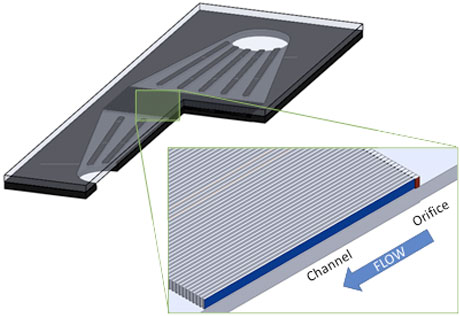Jack Kotovsky | 17-ERD-056
Overview
This project advanced technology related to the thermal management of laser diodes and system-level thermal management. Our research included a modeling component to aid in the hardware design of micro-architected silicon cooling devices suitable for large diode arrays. For the hardware design, we explored surface texturing of the silicon-fin surfaces that yielded a 25% increase in the critical heat flux of the coolers. Finally, we compared four groups of system designs that showed significant performance differences in size, weight, and power (SWaP) performance. A once-through cooling system provided a significant SWaP advantage over other designs.
Background and Research Objectives
Semiconductor laser diodes are the preferred light source to pump laser-gain media, owing to their high brightness and narrow emission spectra, which facilitate powerful and efficient laser systems. Heat removal from laser diodes is the fundamental limitation for increasing the brightness of state-of-the-art laser-diode systems. To advance heat-removal technology, this project pursued the modeling and performance testing of diode coolers and considered system configurations to identify those that most effectively operate these coolers.
Previous work focused on the fabrication and testing of various single- and two-phase microchannel coolers for laser diodes, but testing is a time- and resource-intensive process, making it desirable to minimize device geometries and flow variations. The first objective of this project, then, was to narrow the design space by creating a computational model capable of predicting ideal channel and fin geometries for test devices. We sought to determine what beneficial effect, if any, the addition of wall patterning might have for these test devices. The second objective of this project was to complete the development of a computational model to aid in identifying promising experimental designs for this and future research. Besides optimizing geometry and flow conditions, the patterning of channel walls has the potential to increase heat-transfer performance. We tested the effect of wall patterning on heat-transfer performance. The figure below shows a sample test device cutaway view.
High-power, diode-pumped, directed-energy (DE) systems are composed of local, diode-level cooling architectures, as well as system-level structures that ultimately dissipate the diode waste heat to the surroundings. Many high-power DE systems are in spacious, stationary environments. Consequently, the size and weight demands of a laser system and its surrounding components are of minor importance.
For mobile applications however, system size and weight are paramount factors in mission success. Airborne DE systems are especially burdened with stringent weight restrictions. This project investigated potential thermal-management systems that incorporate a diode-cooling architecture in an airborne mobile platform. Four distinct systems were evaluated for first-order estimation of SWaP performance, emphasizing weight and power. Results showed that a once-through diode-cooling system has the potential to greatly outperform other cooling arrangements for all cumulative event times less than six minutes. Under the conditions examined, a real-time cooling solution outperformed a transient thermal-storage cooling solution.
Impact on Mission
This project supported the NNSA goal to apply science and technology to security challenges. It also enhanced Lawrence Livermore National Laboratory's core competency in lasers and optical science and technology, focusing on the laboratory's research challenge in directed energy. This research can be applied to challenging thermal-management problems, such as optical switching, RF–microwave switching, and neutron generators. The system modeling and design we explored could influence and guide design decisions for various portable and stationary systems with different operational scenarios. Early system planning heavily influences overall technology implementation, as the thermal-management system often drives system SWaP. Results from this research demonstrate a large variation in SWaP trade space, depending on thermal-management architectural approach.
Conclusion
This project advanced the technology and performance of thermal-management systems by improving heat removal from surfaces with extreme thermal fluxes while uniformly controlling temperature across these surfaces. These goals were achieved with multilayer micro-architected structures designed to extract heat within a thin volume. Surface texturing and biphasic fluidics allowed record heat fluxes to be accomplished within the realistic bounds of an airborne platform. Additionally, we explored system-level models and designs in detail to quantify differences among them. SWaP results point strongly towards a once-through, real-time cooling system for the design space explored through this project.
Publications and Presentations
Bandhauer, T. M., et al. High Flux Diode Packaging Using Passive Microscale Liquid-Vapor Phase Change. U.S. Patent 9,768,584, issued September 19, 2017.
Hoke, J., et al. 2018. "Heat Transfer Enhancement in Compact Phase Change Microchannel Heat Exchangers for High Flux Laser Diodes." Proceedings of 15th International Conference on Nanochannels, Microchannels, and Minichannels. Dubrovnik, Croatia. doi:10.1115/ICNMM2018-7664. LLNL-CONF-748527 and LLNL-PROC-743622.






